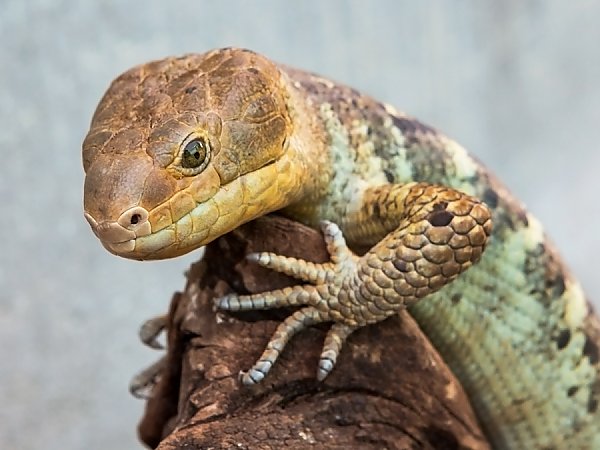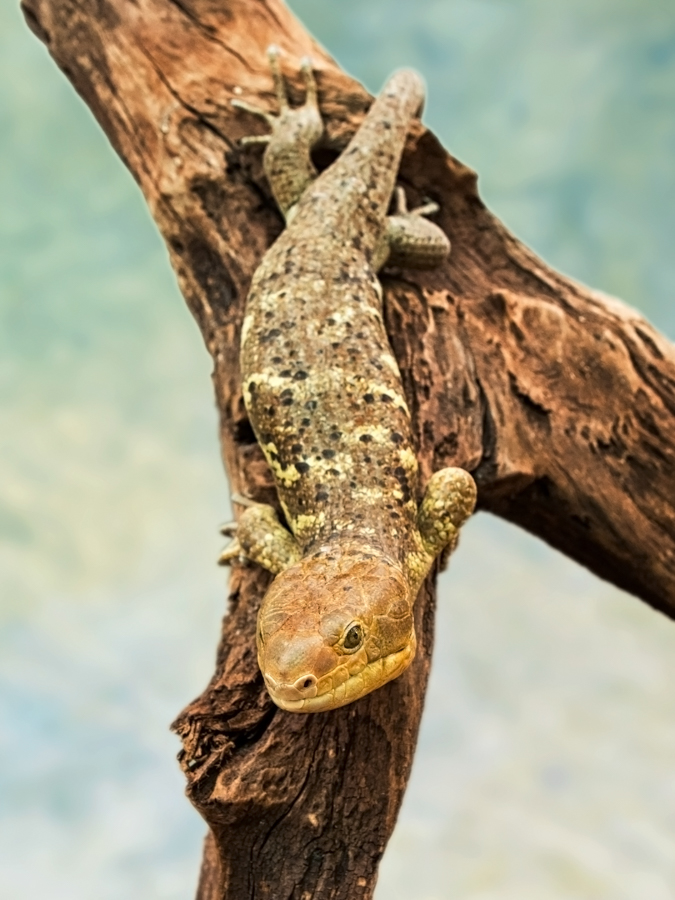Prehensile-Tailed Skink
Corucia zebrata
The prehensile-tailed skink is also known by other common names including Solomon Islands skink, monkey-tailed skink, giant skink, and zebra skink. This arboreal species with its grasping tail is the largest skink in the world. Found in the Solomon Islands, it is a total herbivore. Its olive green body is often speckled with black or light brown, with darker vertical stripes on its back. Its ventral side color varies from light yellow to various shades of green. This species is not listed by the International Union for Conservation of Nature, but it is listed under CITES Appendix II, meaning it is not necessarily threatened with extinction, but its trade must be controlled.


SPECIES IN DETAIL
Prehensile-Tailed Skink
Corucia zebrata
CONSERVATION STATUS: CITES App. II
CLIMATE CHANGE:
At the Aquarium
The prehensile-tailed skink is one of the ambassador animals that participate in meet-and-greets at various locations around the Aquarium, including regular appearances at the Pacific Visions entrance.
Geographic Distribution
This species is found in the Solomon Islands.
Habitat
Prehensile-tailed skinks live in tropical forests.
Physical Characteristics
This species has a long, slim, cylindrical body and a grasping tail. Its tail makes up half of the body length. Its olive green body is often speckled with black or light brown, and it has darker vertical stripes on its back. Its ventral side color varies from light yellow to various shades of green. This skink’s toes have thick, curved nails used for climbing and gripping tree limbs. Prehensile-tailed skinks have short, strong legs and a triangular head with small round eyes. They have small teeth, a strong, crushing jaw, and good eyesight and sense of smell.
Size
Prehensile-tailed skinks are 30 inches (75 centimeters) in length. Their tail represents half of their length.
Diet
This species feeds primarily at dusk and dawn. It is an herbivore that eats leaves of a variety of fruits, vegetables, and plants.
Reproduction
Prehensile-tailed skinks reach sexual maturity at two years or older. Breeding and birth may occur any time during the year. Gestation lasts approximately six months, with the female giving birth to one or occasionally two very large offspring that are approximately half the size of the mother. A rare trait among reptiles, the mother provides a placenta for its young, and this species will show parental care and will protect their young.
Behavior
This nocturnal species relies completely on trees for shelter and food. It is one of the few reptile species known to function within a social group. A pair of skinks bond and claim a territory that they will fiercely protect. As a defense, this skink will make a sharp hissing noise and may deliver a vicious bite.
Adaptation
This skink’s prehensile tail helps it move through or anchor in trees.
Longevity
Prehensile-tailed skinks can live over fifteen years.
Conservation
Habitat loss and extensive logging are serious threats. Wild populations are also threatened by excessive pet trade exports and consumption for food. Export of this species from the Solomon Islands is restricted.
This species is not listed by the International Union for Conservation of Nature, but it is listed under CITES Appendix II, meaning it is not necessarily threatened with extinction, but its trade must be controlled.
SPECIES IN DETAIL | Print full entry
Prehensile-Tailed Skink
Corucia zebrata
CONSERVATION STATUS: CITES App. II
CLIMATE CHANGE:
The prehensile-tailed skink is one of the ambassador animals that participate in meet-and-greets at various locations around the Aquarium, including regular appearances at the Pacific Visions entrance.
This species is found in the Solomon Islands.
Prehensile-tailed skinks live in tropical forests.
This species has a long, slim, cylindrical body and a grasping tail. Its tail makes up half of the body length. Its olive green body is often speckled with black or light brown, and it has darker vertical stripes on its back. Its ventral side color varies from light yellow to various shades of green. This skink’s toes have thick, curved nails used for climbing and gripping tree limbs. Prehensile-tailed skinks have short, strong legs and a triangular head with small round eyes. They have small teeth, a strong, crushing jaw, and good eyesight and sense of smell.
Prehensile-tailed skinks are 30 inches (75 centimeters) in length. Their tail represents half of their length.
This species feeds primarily at dusk and dawn. It is an herbivore that eats leaves of a variety of fruits, vegetables, and plants.
Prehensile-tailed skinks reach sexual maturity at two years or older. Breeding and birth may occur any time during the year. Gestation lasts approximately six months, with the female giving birth to one or occasionally two very large offspring that are approximately half the size of the mother. A rare trait among reptiles, the mother provides a placenta for its young, and this species will show parental care and will protect their young.
This nocturnal species relies completely on trees for shelter and food. It is one of the few reptile species known to function within a social group. A pair of skinks bond and claim a territory that they will fiercely protect. As a defense, this skink will make a sharp hissing noise and may deliver a vicious bite.
This skink’s prehensile tail helps it move through or anchor in trees.
Prehensile-tailed skinks can live over fifteen years.
Habitat loss and extensive logging are serious threats. Wild populations are also threatened by excessive pet trade exports and consumption for food. Export of this species from the Solomon Islands is restricted.
This species is not listed by the International Union for Conservation of Nature, but it is listed under CITES Appendix II, meaning it is not necessarily threatened with extinction, but its trade must be controlled.

